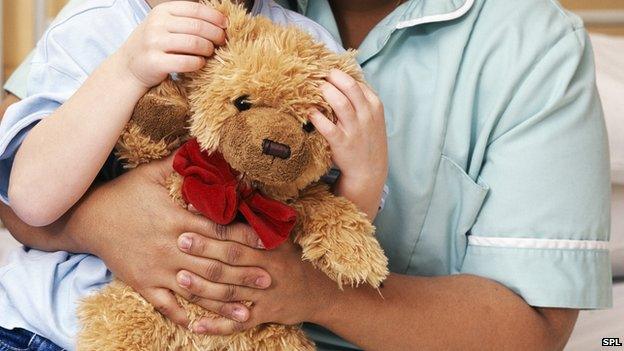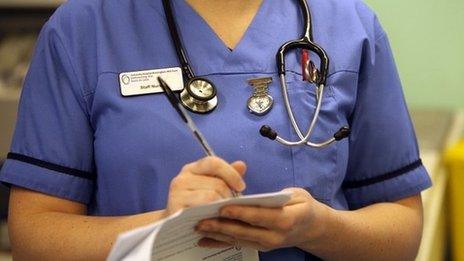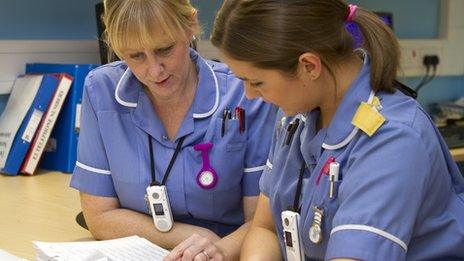Safe nursing levels recommended
- Published
- comments

The guidelines say there must be enough nurses to give patients the assistance they need
Patients are at risk of harm if a nurse has to care for more than eight people on a ward during the day, draft NHS guidance suggests.
The National Institute for Health and Care Excellence (NICE) said hospitals in England should be wary about that workload being exceeded.
But it stopped short of stipulating one to eight was an absolute minimum, saying flexibility might be required.
The Department of Health said the number of front-line staff had risen.
While individual hospitals are currently allowed to set their own nurse staffing levels, NICE was asked to look at the issue by ministers.
They had promised to explore safe staffing levels following the public inquiry into the Stafford Hospital scandal.
Prof Gillian Leng, NICE: Care needs to be tailored to the patients' needs
NICE said in its draft guidance that in a situation where the recommended ratio of at least one nurse to eight patients had not been met, the hospital should be able to explain why.
'Red flag'
There could be cases, for example, where patients' illnesses and needs were less serious, and, therefore, it would be wrong to set strict thresholds, it said.
But the guidance recommends nurses raise the alarm - or a "red flag" - when care is being compromised, no matter what the ratio.
That could include situations where there are not enough staff to help patients use the toilet, monitor their vital signs or administer medication.
NICE deputy chief executive Prof Gillian Leng said: "There is no floor or ceiling number on the required number of nursing staff that can be applied across the whole of the NHS."

Professor Gillian Leng of NICE said there was no "magic number" for staffing
She said decisions about the number of nursing staff should "allow flexibility on a day-to-day or shift-by-shift basis".
Speaking to Radio 4's Today programme, Prof Leng added that while there was "no magic number" for staffing levels, "care needs to be tailored to the patient's needs".
BBC health correspondent Nick Triggle said: "It is already accepted that in areas such as critical care ratios are essential.
"But applying this to general wards is another matter - and could have major implications for overall nurse numbers."
The guidance, which is now being consulted on before the final recommendations are made in the summer, applies to general acute wards.
Specialist areas such as maternity, paediatrics, and accident and emergency will get their own guidance at a later stage.
Many hospitals have already started paying close attention to nurse numbers; for example, a number publicly display actual staffing levels on wards along with what they should be.
NHS England wants this to become routine across the health service, while later this year hospitals will have to submit their staffing levels each month so they can be displayed on the NHS Choices website.
'Sensible' guidance
Royal College of Nursing general secretary Peter Carter said: "For any patient to receive substandard care is unacceptable.
"Nurses will be hoping that once the full set of guidelines is completed, the NHS will never again be so vulnerable to short-term financially-driven decisions about patient care."
He told the Today programme that it was important a ratio of one nurse to eight patients did not become mandatory as there were some settings - such as neonatal wards - where one-to-one care is needed.
To have a situation where "the minimum becomes the maximum" is "in no-one's interests", he added.
The guidance does not go far enough, according to former NHS Trust chairman Roy Lilley.
He said: "If you go on holiday and you fly, the steward to passenger ratio is prescribed in law. If you leave your kids at a creche, the carer to kids ratio is prescribed in law.
"If you got to a football ground, the steward to spectator ratio is prescribed in law. But if you leave your granny in a hospital ward, it's left to one of Gillian Leng's red flags."
'Step forward'
A spokesman for the Foundation Trust Network, which represents hospitals, said the guidance was "sensible" and supported what many trusts were already doing, however.
"Local nursing and clinical teams are best placed to make the judgement on what is best for their patients," he added.
The guidance also applies to Wales, although it will now be up to ministers there whether it will be applied.
In Scotland, hospitals are already routinely monitoring and publishing staffing levels - although there are no recommended minimums.
Health Secretary Jeremy Hunt said: "NICE's work on staffing is a major step forward - for the first time in its history, the NHS will have the evidence it needs to make sure that nurses are able to spend enough time with their patients."
A Department of Health spokesman said the number of admin staff and managers in hospitals had been cut since 2010 but there were 5,100 more nurses working on wards.
"We have increased the NHS budget in real terms and are clear that hospitals must balance their books whilst ensuring compassionate, quality care for all. We know this can and is being done," he said.
- Published11 March 2014

- Published3 March 2014

- Published5 February 2014

- Published19 November 2013

- Published19 November 2013